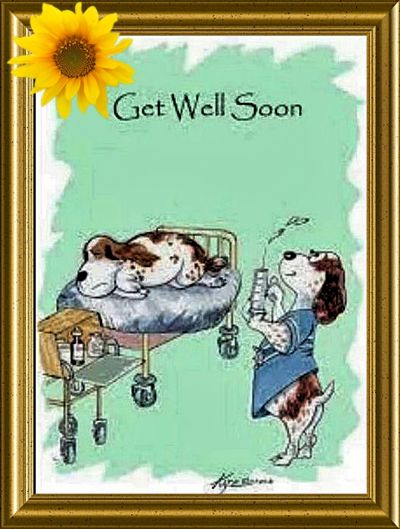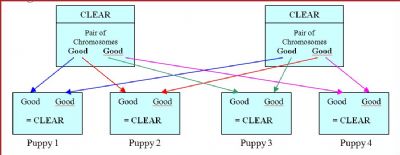RHEGED | Understanding Genetics & Tests
Useful links regarding the inheritance of how autosomal recessive genetic disorders are
inherited in the ESS & genetic inheritance at a glance.
PATTERNS OF INHERITANCE:
The specific pattern of inheritance has not been established for many of the disorders that are believed to be inherited. Where the mode of inheritance is not known, breeds that have an increased risk relative to other dog breeds are said to have a breed predisposition for a particular condition.
THE FOLLOWING DESCRIBES KNOWN PATTERNS OF INHERITANCE.
AUTOSOMAL DOMINANT:
Only 1x copy of the gene, which may be inherited from either parent, is required to produce the trait. The parent with the dominant trait will pass the affected gene to approximately half its offspring, and the trait will be apparent in both the parent and the affected progeny. These conditions are uncommon because, as long as it is of early-onset (i.e becomes apparent before breeding age is reached), the disorder can be readily eliminated by avoiding the breeding of affected individuals. In many instances, however, there is incomplete dominance. The trait may be dominant with variable expressivity, which means that if either parent is affected, all puppies have a susceptibility to the disorder, but not all will be affected equally. Alternately, a dominant trait may have incomplete penetrance. If penetrance is 75% for example, only about 3 quarters of the pups who inherit the trait will express it.
This is the most common mode of inheritance for genetic conditions in dogs. Progressive Retinal Atrophy (PRA) & Phosphofructikinase (PKF) are such traits. To be affected, the animal must inherit 2 x copies of the gene (genotype 'pp'); 1 from EACH parent. Dogs with the genotype 'pp' (normal) or 'Pp' (carrier) will be clinically normal BUT the CARRIER will pass the affected gene to approximately half the offspring. As long as CARRIERS (Pp) are mated to CLEAR (PP) normal animals, the offspring will be unaffected but some will remain CARRIERS. If 2 x CARRIERS are mated, some of the offspring (approximately 25%) will be affected.
As long as the frequency of a gene for a recessive disorder remains low in the population, the particular gene may be passed along for many generations before by chance 2 x CARRIERS are mated & affected individuals are born. However, the gene frequency may become unusually high due to breeding to close family members, or because of 'popular sire' effect, where a sire with a harmful recessive gene is mated frequently because of desirable traits. Because the recessive gene is carried in the population in outwardly normal animals, it is very difficult to eradicate these traits. However the incidence can be reduced by identification of CARRIERS through test matings or through tests that have been developed (ie: DNA testing), & the conscientious use of this information in breeding programs. Veterinarians, dog breeders & breed associations must all work together for substantial progress to be achieved.
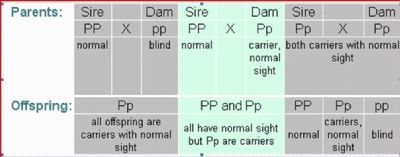
In these traits, the gene is located on the 'X' chromosome. Males have 1 x 'X' chromosome from their mother, & 1 x 'Y' chromosome from their father, which carries little information other than maleness. Females have 2 x 'X' chromosomes, 1 x each from their mother and father. So if a mother who is a carrier for a harmful recessive gene ('Xx') passes the recessive gene ('x') to her daughter, the daughter will be a UNAFFECTED CARRIER, but her sons who receive that gene will be affected.
- All of the gens inherited by dogs are contained within 39 different sets of chromosomes. There are thought to be between 50,000 - 70,000 defferant genes.
- Any chromosome between number 1 & 38 is called an 'autosome'. The 39th chromosome determines the sex of the dog.
- The genes responsible for diseases such as PRA, PKF & Fucosidosis (FS or FUCO is ONLY found in the ESS), are inherited through what is known as an AUTOSOMAL RECESSIVE TRAIT.
- Chromosomes (& therefore genes), are inherited in pairs, with 1x copy of each chromosome being inherited from each parent, making up a total of 39 pairs.
- With all diseases which are inherited through a simple autosomal recessive gene, every dog can be classified genetically in one of 3x ways.
|
AFFECTED
The dog has 2 x FAULTY COPIES of the chromosome.
AFFECTED dogs will themselves suffer from the condition & will automatically pass the on the faulty gene to their offspring Inherited pair of chromosomes
= FAULTY + FAULTY |
|
CARRIER The dog has 1 x GOOD COPY & 1 x FAULTY COPY of the chromosome which contains the gene responsible for Inherited pair of chromosomes |
|
CLEAR
The dog has 2 x GOOD COPIES of the chromosome. A CLEAR dog will not, therefore, suffer from the disease; neither can it pass on the faulty gene to its offspring. It is both clinically & genetically CLEAR Inherited pair of chromosomes |
- When 2 dogs are mated, the puppies inherit 1 x copy of each chromosome from each parent, resulting in a number of possible combinations depending on the genetic status of each parent.
- The following diagrams illustrate the possible results from each different combination of matings.
- The results show what will happen ‘statistically’ or ‘on average’ with each combination of mating.
For example, if 2 x carriers are mated together, statistically a quarter of the litter will be genetically CLEAR, half of the litter will be genetically CARRIERS & the remaining quarter will be AFFECTED.
- Any 1 x individual mating can vary enormously from the statistical averages ~ this is where an element of ‘chance’ comes into it, rather like the tossing of a coin. For example, a litter of 8 puppies should, statistically, be made up of 50% dogs & 50% bitches. Yet we all know that in any 1 x litter this can vary greatly & it is perfectly possible to have a litter containing 8 dogs & no bitches or vice versa. On average though over the course of thousands of litters, the numbers would even out in line with the statistical probabilities & the same is true of genetically inherited diseases.
- The following diagrams, therefore, show what CAN & WILL happen statistically & they illustrate the risks involved with each type of mating. The arrows show which copy of each chromosome is inherited by each puppy from its parents & the genetic results.
|
|
CLEAR → CLEAR Whatever combination of chromosomes each puppy inherits as both parents are CLEAR only good copies of each chromosome are available. Therefore each puppy will automatically inherit 2x GOOD COPIES making it genetically CLEAR. |
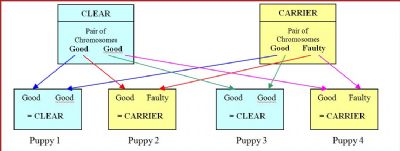 |
CLEAR → CARRIER When a CLEAR is mated to a CARRIER statistically ½ the litter will be CLEAR (having inherited 2x good copies of the chromosome) the litter & ½ the litter will be CARRIERS (having inherited 1x good & 1x faulty copy). |
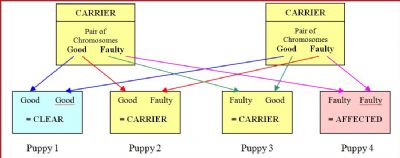 |
CARRIER → CARRIER When 2 x CARRIERS are mated together statistically ½ the litter will be CARRIERS (having inherited 1x good copy of the chromosome & 1x faulty copy) & ¼ will be CLEAR (having inherited 2x good copies), a ¼ will be AFFECTED (having inherited 1x faulty copy). |
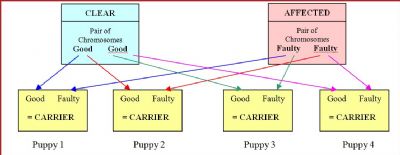 |
CLEAR → AFFECTED When CLEAR is mated to AFFECTED all the puppies will be CARRIERS having inherited 1x good copy of the chromosome from the CLEAR parent & 1x faulty copy from the AFFECTED parent. NB: ALL offspring of AFFECTED animals are automatically CARRIERS even if mated to a CLEAR. |
 |
CARRIER → AFFECTED |
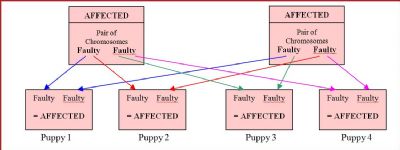 |
AFFECTED → AFFECTED |
WHAT DOES ALL THIS TELL US?
- When 2 x genetically CLEAR dogs are mated together, all the resulting offspring will also be genetically CLEAR.
- When mating a genetic CLEAR to a genetic CARRIER, no AFFECTED dogs will be produced, but, statistically, half the litter will be CARRIERS.
- CARRIERS should never be mated to other CARRIERS as, statistically, half the litter will be CARRIERS and a quarter of the litter will be AFFECTED.
- The offspring of AFFECTED dogs will all automatically be CARRIERS at the very least, even when mated to a CLEAR dog.
- The parents of AFFECTED dogs will both automatically be CARRIERS or AFFECTED.
All content copyright © 2015

